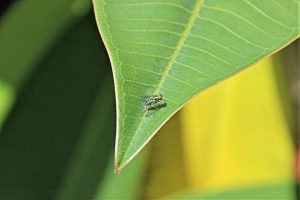
Have you ever seen a tiny, metallic blue-green fly flitting to and fro on leaves and flowers in your garden? You have probably seen it but dismissed it as some either troublesome or benign winged insect not requiring a second look. However, this tiny glint of color is a very helpful predator of pest insects. Let’s give due credit to the long-legged fly – a favorite and under-appreciated predator.
First, long-legged flies are not pests like a “whitefly” which is not even a fly or considered a filth-breeding fly like a greenbottle fly. Your garden is in fact likely full of long-legged flies. We have a few flowers and ornamentals planted just outside our office door and I found a long-legged fly on a plumeria in no time at all. This insect is in the order Diptera which means “two wings”. Considered a “true fly”, this tiny insect is only about one-quarter of an inch in size but does truly have long legs in proportion to its body. Many are metallic blue-green, bronze-green, or even red, silver or gold-tinted as the light reflects off their bodies like a dazzling gem. Like all true flies, they have a complete metamorphic life cycle going from egg to larvae and then to pupae and adult. Both the larval and adult stage feed on various prey. Adults are particularly noted to feed on pests that we could do without such as gnats, bark beetles, mites, aphids, thrips, and mosquitoes. The adult flies capture prey and extract liquids with special mouthparts. Larvae can be predacious but may also simply be scavengers.
While noted to favor shaded, or partially shaded sites in landscapes, I have found many perched-on foliage in sunny areas – especially on citrus, plumeria and other larger-leaved plants. There may be several spotted on the same plant at times. As part of Integrated Pests Management or IPM, conserving this petite creature is a way to biologically suppress pests to level we can live with. Eradication is rarely practical or possible, but suppression including using already existing biological controls such as long-legged flies, simply adds to our tool kit of methods and techniques.
Long-legged flies are both colorful to the eye and helpful behind the scenes as they go about their business of eating landscape pests. So, don’t accidently eliminate or take for granted natural predators that are in your landscape doing work for you for free! For more information on all types of natural predators and parasites, or to ask a question, you can also call the Master Gardener Volunteer Helpdesk on Mondays, Wednesdays, and Fridays from 1 to 4 pm at 764-4340 for gardening help and insight into their role as an Extension volunteer. Ralph E. Mitchell is the Director/Horticulture Agent for UF/IFAS Extension – Charlotte County. He can be reached at 941-764-4344 or ralph.mitchell@charlottecountyfl.gov . Connect with us on social media. Like us on Facebook @CharlotteCountyExtension and follow us on Instagram @ifascharco.
Resources:
Pritchard, S. (2022) Flying Gems : Long-Legged Flies. South Dakota State University Extension.
Texas Long-Legged Flies (2022) Galveston County Master Gardeners – Texas A&M AgriLife Extension Service.
Dolichopodidae (2023) https://en.wikipedia.org/wiki/Dolichopodidae.
BugGuide (2023) Iowa State University Department of Plant Pathology, Entomology, and Microbiology.
 4
4
